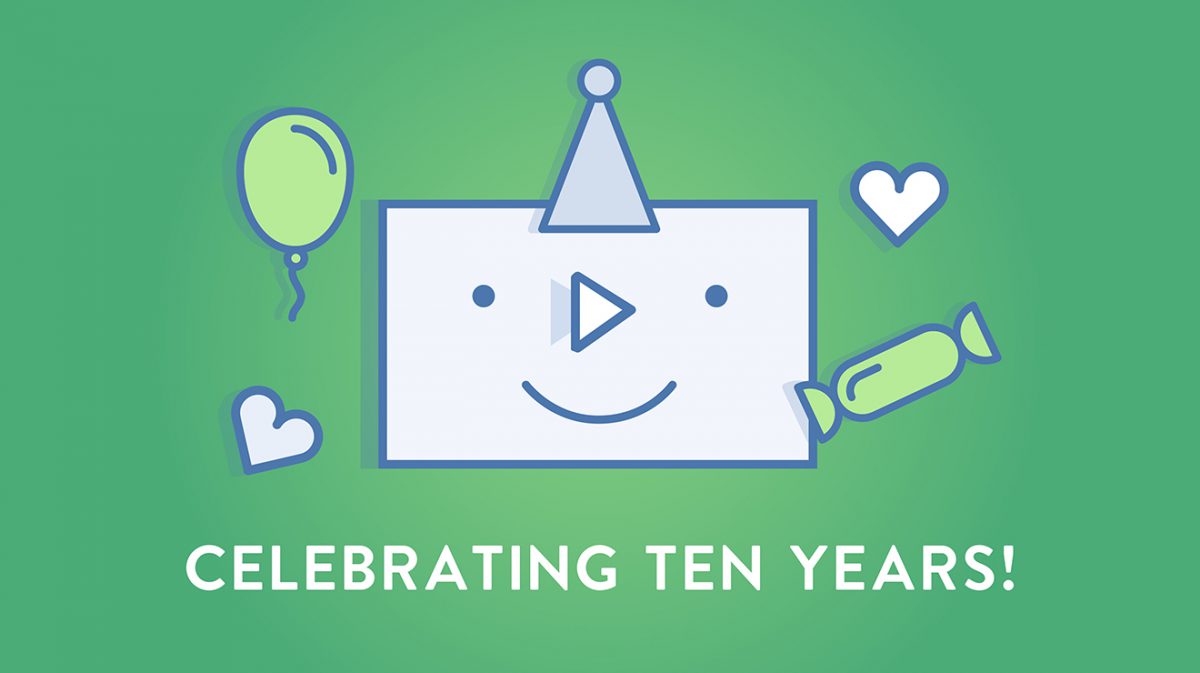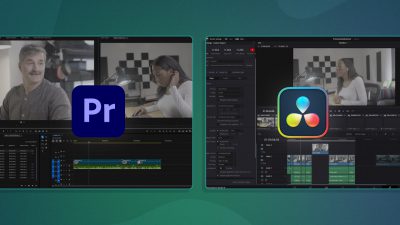SproutVideo is celebrating ten years in business! That’s ten years of growth as a bootstrapped company, and unrelenting focus on all things video. Here are our top takeaways from what we’ve learned over the past decade, and what we’re excited about for the future.
1. Video Will Keep Getting Easier, and Harder, to Produce
On its face, that’s clearly a contradictory statement. But hear me out.
There’s no question that it’s easier than ever to produce a quality video. The phone in your pocket can shoot 4K, and beyond that, other tools and software keep becoming more accessible and user-friendly.
As video becomes easier and easier to make, people create more of it, and watch more of it. There’s a certain level of desensitization and fatigue that accompanies that. Just think about how you react to seeing yet another Zoom meeting on your calendar.
It’s therefore harder to create content that grabs attention and engages viewers. Standards for production values keep inching higher, and viewers are faced with more choices than ever before.
So, what can you do? Keep producing content, keep tabs your competitors, and constantly check for ways to improve.
2. The Promise of AI for Video Has Yet to Be Fulfilled
It seems like every year, predictions are made for ways AI will revolutionize video production. We’ve seen headlines that made it seem like camera operators and editors would want to find new careers, and fast.
While much has changed, video production remains very much the same. It’s true that progress has been made in terms of the capabilities of AI for video production, but there has yet to be a meaningful impact on the way most video is produced.
One major exception is the advances made in drones. The latest drones can recognize and track a subject, even if they move out of frame and reappear, with automatic obstacle avoidance and landing. They practically fly themselves at this point.
Looking to the future, it’s a matter of time before video production will become more efficient and automated as AI for filming and editing becomes more ubiquitous. Until then, we’ll keep recording and cutting footage the old-fashioned way.
3. Video Has Redefined Communications
When SproutVideo first launched back in 2010, Youtube was only five years old. Online video was seen almost exclusively as entertainment, and producing video was very expensive and time-consuming. Consequently, much of our earlier marketing efforts were directed at convincing companies that video was a worthwhile investment.
Clearly, much has changed since then. Video is significantly easier and, in many cases, less expensive to produce. Many organizations have shifted to a video-first way of communicating, both internally and publicly.
We see two main reasons why video has taken off for business communications:
- A chance to be more personal
- A chance to tell AND show
Be More Personal
Video allows you to foster a stronger connection with prospects and customers, as well as employees, without actually meeting face-to-face. It’s not really possible to communicate with the same level of nuance via text and still images.
Tell AND Show
With text or still images, you can tell people all about your products and services. With video, you can actually show them in action.
The impact is significant, and measurable. According to Wyzowl, a majority of consumers would prefer to watch a video about a product than read information about it. In that context, it’s not surprising 95% of marketers agree video improves the customer’s understanding of a product, and has been shown to improve conversion rates.
4. Basic to Polished – There’s a Place for Every Level of Production
It’s natural to want to make the very best video possible, but we’re here to tell you something surprising. It’s not always necessary to take your production values to the nth degree.
In fact, different types of video serve different purposes, and there’s room for all levels of quality provided the production matches the goal of the video.
Shorter is Better. Mostly … Unless it’s Not
Conventional wisdom dictates that shorter videos have better engagement. But the reality is that engagement is more tied to the quality of your content and how well it’s targeted at your intended audience than anything else.
Of course, depending on where you’re sharing your video, you might run into hard limits in terms of length. Certain social platforms or video ad placements come with strict length requirements.
Outside of those particular uses, the ideal runtime of video can vary significantly. After all, humans will watch anything from a six second ad spot to a feature length film.
So what video length is ideal? What is right for you? It all depends on your message, audience, platform, and how you want to tell your story.
You Can Do a Lot With a Little
It can be intimidating to get started with video if you’re of the mindset that you need lots of fancy, expensive gear to produce high quality video. We’re here to tell you that’s just not the case.
There are many, many ways to put a video together, ranging from basically free to incredibly expensive. At the bottom of the range, you’d be surprised what you can put together with a little time and effort.
Of all the tips we could offer on this point, it really boils down to diving in and getting your hands dirty. Practice makes perfect. The more video you make, the better you’ll get at it, no matter what tools you’re working with.
You Can Do More With More
Obviously, gear helps. A bigger budget helps. The right location, lens, lighting, and editing software can add style and make your video stand out from the crowd. Similarly, the larger your crew and the more specialized your talent, the more unique and polished your video is likely to be.
Borrow, rent, or buy – whatever your budget allows. If you’re unsure what you need for your next project, our How To Video series has guides to the important differences between cameras, lighting options, and microphones to help you get started.
5. The Power of Live Video
For built-in excitement, it’s hard to beat live video. While it’s been around for sports, news, and events for a long time, it’s finally become a common practice for businesses too.
The draw for viewers can’t be ignored. A majority of viewers would rather watch a live video than read a blog post or view social media content, and no wonder. Nearly 80% of marketers have found that live video drives authentic engagement with their audiences.
If your organization is among the 45% of businesses that have yet to start live streaming, there’s no time like the present to go live. Here are six simple steps to live streaming for business, and our guide to multi-source live streaming to help you get started.
6. The Value of Evergreen Video
As a counterpoint to the above, evergreen video is the rare video that stays relevant for a long time and continues to appeal to viewers. While live video has a right here, right now pull, evergreen video has lasting value.
Generally speaking, evergreen video is hard to make, but here are some tips that can help.
- Focus on providing value to viewers above all else.
- Try to answer a timeless question rather than responding to a particular trend.
- Invest in the quality of the video so it doesn’t become dated after a few months.
- Make updates to the video over time if needed.
For more inspiration, read our post about fourteen types of evergreen video you can make for your business.
7. Video Remains an Art, Not a Science
The best marketers and video producers care about the success of a video, and rely on different data points to inform their definition of success. For instance, viewer engagement can tell you a lot about whether a video succeeded in getting your message across to your intended audience.
Also, the tools that enable video creation are increasingly technical and automated. For instance, CGI has come a long way since the early days when it was blatantly obvious which elements were filmed in real life and which were not.
However, despite all the data and all the technology that goes into making a video, you can’t replace or fake artistic vision. We believe that’s what really separates the good from the great when it comes to video.
What it boils down to is storytelling. The tech and data are important tools, but ultimately, they serve the message, not the other way around. Without a hook, a story to tell, and some creativity, all the data and gear in the world won’t help your video succeed.
The Hook
To grab the attention of your audience, and keep it, you need a hook. Whether it’s the overall plot or just the first few seconds of your video, the hook is what keeps the audience engaged and glued to the screen.
Essentially, an effective hook will indicate what your audience will get out of watching your video, but leaves them wanting more. If you need some inspiration, a popular Netflix series might help, or, try thinking of it like a teaser video.
The Story
Storytelling is not just for fiction. Any story, even an informational video, can be told in a compelling way. From imaginative advertising to corporate videos and feature length films, there is surely a story to tell.
When we hear “story” we think fiction – of happily ever after. But you can consider any message a story insofar as it should be clear, concise, compelling and make your audience want to be along for the journey. Whether it’s action, adventure, comedy, or instructions on how to hook up a dishwasher, there’s an interesting way to tell each story. Taking responsibility for the craft of the story will make sure you don’t lose viewers.
While it’s true that what makes a great story can be broken down into data points and formulaic story arcs, it’s equally true that the best storytellers often thwart convention.
Creative Approach
Your story might be a tale as old as time, but with the right approach, it can feel fresh and resonate with viewers. By nurturing and channeling creativity, you can find your own style and stand out from the crowd.
Refer back to the first lesson. More video is being created today than ever before. To rise above the noise, you need to do things differently.
8. Inspiration Can Come From Anywhere
If part of your job requires you to be creative, you’ve probably encountered some form of writer’s block at some point. Everyone has a trick or two for overcoming it, but here’s what we’ve found really works.
Take notes, whether written, recorded, or photographed. Inspiration can strike at the strangest of times in the oddest of places. If you can make it a habit to capture your thoughts when they occur, you can start to build up a bank of ideas to draw upon when the time comes.
Mix up your exposure to different experiences, ways of life, and types of media. The cross-pollination of ideas can help enhance your creative process in unexpected ways. It could be as simple as a museum trip or joining a local meetup group, but whatever it is, get out there and get it started.
9. Bring it In-House
There will always be a need for video studios. Different types of productions necessitate specialized experts, or a large crew, certain equipment, or a particular style.
However, the demand for video is so high that in order to keep up with it, organizations need to bring it in-house. Not all of it. But enough so that you can produce the videos you need on a regular basis with ease.
As long as video remains a special project, it will require too much effort to become a regular part of your marketing and communications. If the tools are right there, and it’s easier to jump in front of the camera, it will become second nature.
10. We Haven’t Hit Peak Video
This is the culmination of all the prior points: despite the increasing volume, advances in technology, and innovative uses appearing every day, we still have not hit peak video.
In fact, we don’t know what peak video will even look like. The goalposts keep moving towards the horizon.
We’re excited to see where certain trends will take us. In particular:
- Greater diversity in the voices and stories being told.
- More efficient and powerful video workflows.
- Better, cheaper, smaller, and lighter gear.
Ten years ago, we felt like video was an exciting and expansive opportunity for business, and of all the things that have changed, that still holds true.
What will the next ten years hold? Share your insights in the comments below.








